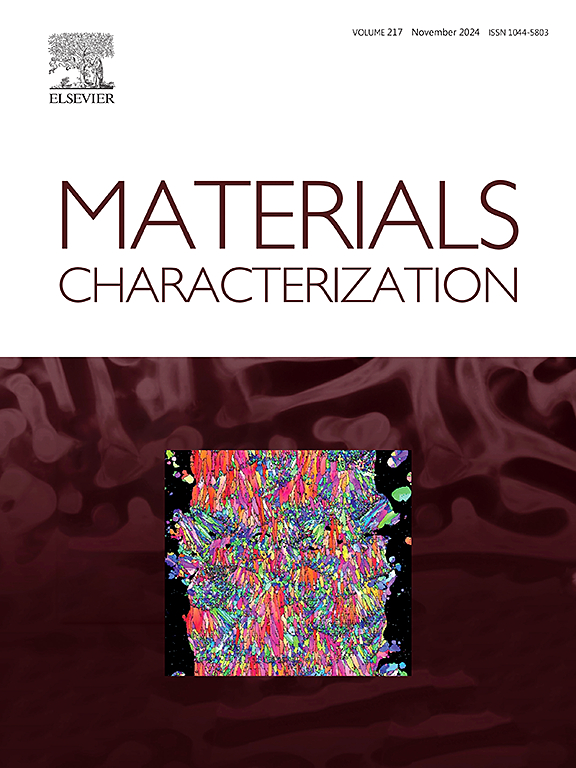ODS-W/Cu接头的连接加固设计:将非混相界面转变为双反应扩散界面
IF 5.5
2区 材料科学
Q1 MATERIALS SCIENCE, CHARACTERIZATION & TESTING
引用次数: 0
摘要
不同金属(如钨(W)和铜(Cu))之间固有的冶金不相容性导致了弱的化学结合,极大地限制了高强度的获得。这对要求界面完整性的核聚变应用构成了一个关键的限制。为了解决这些限制,本研究引入了采用CrCoNi介质熵合金(MEA)中间层的双界面强化策略,并通过火花等离子烧结(SPS)技术实现了氧化物扩散强化钨(ODS-W)和Cu的扩散结合。在优化的连接温度为1000℃时,接头的最大抗拉强度为256.7±8.2 MPa,比直接连接(DB)接头(94.6±5.1 MPa)提高了171%,同时断裂模式从脆性断裂转变为韧性断裂。多尺度微观结构和界面元素扩散行为分析表明,W/MEA界面的反应扩散促进了溶液强化基体的形成,并伴有非晶扩散层。而Cu/MEA界面处的相互扩散诱导出多相结构,导致固溶强化和析出强化同时发生,从而强化界面结合。这种双界面强化方法为提高非混相金属体系的力学性能建立了一种有效的设计策略。本文章由计算机程序翻译,如有差异,请以英文原文为准。
Connection reinforcement design of ODS-W/Cu joint: Transforming immiscible interface into dual reaction diffusion interface
The inherent metallurgical incompatibility between dissimilar metals such as tungsten (W) and copper (Cu) engenders weak chemical bonding, substantially constraining the attainment of high strength. This constitutes a critical limitation for nuclear fusion applications demanding robust interfacial integrity. To address these limitations, this study introduces a dual interface reinforcement strategy employing a CrCoNi medium entropy alloy (MEA) interlayer and achieving diffusion bonding of oxide diffusion-strengthened tungsten (ODS-W) and Cu through spark plasma sintering (SPS) technology. At the optimized bonding temperature of 1000 °C, the joint achieves a maximum tensile strength of 256.7 ± 8.2 MPa, corresponding to a 171 % enhancement over direct bonding (DB) joint (94.6 ± 5.1 MPa), accompanied by a fracture mode transition from brittle to ductile failure. Multi-scaled microstructure and interface element diffusion behavior analyses reveal that reactive diffusion at the W/MEA interface facilitates the formation of a solution-strengthened matrix associated with an amorphous diffusion layer. Whereas mutual diffusion at the Cu/MEA interface induces multiple phase structures, resulting concurrently in solid solution strengthening and precipitation strengthening, thereby reinforcing the interface bonding. This dual interface reinforcement methodology establishes an effective design strategy for enhancing mechanical properties in immiscible metal systems.
求助全文
通过发布文献求助,成功后即可免费获取论文全文。
去求助
来源期刊

Materials Characterization
工程技术-材料科学:表征与测试
CiteScore
7.60
自引率
8.50%
发文量
746
审稿时长
36 days
期刊介绍:
Materials Characterization features original articles and state-of-the-art reviews on theoretical and practical aspects of the structure and behaviour of materials.
The Journal focuses on all characterization techniques, including all forms of microscopy (light, electron, acoustic, etc.,) and analysis (especially microanalysis and surface analytical techniques). Developments in both this wide range of techniques and their application to the quantification of the microstructure of materials are essential facets of the Journal.
The Journal provides the Materials Scientist/Engineer with up-to-date information on many types of materials with an underlying theme of explaining the behavior of materials using novel approaches. Materials covered by the journal include:
Metals & Alloys
Ceramics
Nanomaterials
Biomedical materials
Optical materials
Composites
Natural Materials.
 求助内容:
求助内容: 应助结果提醒方式:
应助结果提醒方式:


